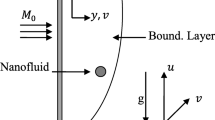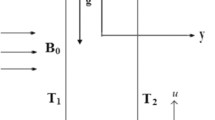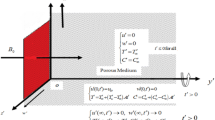Abstract
Similarity solutions of laminar electromagnetohydrodynamic boundary layer flows in forced convection are investigated aiming at the evaluation of irreversible momentum, heat and mass transport balance equations by a variational principle. The transportation fields inside the boundary layer are approximated as trial polynomial functions, and the functionals of variational principle are formulated. The Euler–Lagrange equations of variational principle are constructed as algebraic equations in terms of momentum, thermal and concentration boundary layer thicknesses. Electrically conductive fluid flow over a semi-infinite flat plate controlled by electromagnetic force (Z) is considered. The effects of viscous dissipation (Ec), thermophoretic particle deposition (Nt) and thermal diffusion (Sr) in the presence of heat source/sink (Q) on skin friction, heat and mass transfer rates have been examined in this work. To demonstrate the efficiency of the present technique, some specific obtained results are compared with the known numerical results in literature and the accuracy is ensured. Further, the regression analysis is performed to state the dependency of these parameters on heat and mass transfer rates.























Similar content being viewed by others
References
Gad-el-Hak M. Flow control: passive, active, and reactive flow management. Cambridge: Cambridge University Press; 2000. p. 27–30.
Gailitis AK, Lielausis OA. On the possibility of drag reduction of a flat plate in an electrolyte. Appl Magnetohydrodyn. 1961;12:143–6.
Weier T, Fey U, Gerbeth G, Mutschke G, Lielausis O, Platacis E. Boundary layer control by means of wall parallel Lorentz forces. Magnetohydrodyn. 2001;37:177–86.
Magyari E, Pantokratoras A. Aiding and opposing mixed convection flows over the Riga plate. Commun Nonlinear Sci Numer Simul. 2011;16:3158–67. https://doi.org/10.1016/j.cnsns.2010.12.003.
Watanabe T, Pop I. Thermal boundary layers in magnetohydrodynamic flow over a flat plate in the presence of a transverse magnetic field. Acta Mech. 1994;105:233–8. https://doi.org/10.1007/BF01183954.
Goren SL. Thermophoresis of aerosol particles in the laminar boundary layer on a flat plate. J Colloid Interface Sci. 1977;61:77–85. https://doi.org/10.1016/0021-9797(77)90416-7.
Talbot L, Cheng R, Schefer R, Willis D. Thermophoresis of particles in a heated boundary layer. J Fluid Mech. 1980;101:737–58. https://doi.org/10.1017/S0022112080001905.
Mills AF, Hang Xu, Ayazi F. The effect of wall suction and thermophoresis on aerosol particle deposition from a laminar boundary layer on a flat plate. Int J Heat Mass Trans. 1984;27:1110–3. https://doi.org/10.1016/0017-9310(84)90127-3.
Chang YP, Tsai R, Sui FM. The effect of thermophoresis on particle deposition from a mixed convection flow onto a vertical flat plate. J Aerosol Sci. 1999;30:1363–78. https://doi.org/10.1016/S0021-8502(99)00023-3.
Selim A, Hossain MA, Rees DAS. The effect of surface mass transfer on mixed convection flow past a heated vertical flat permeable plate with thermophoresis. Int J Therm Sci. 2003;42:973–82. https://doi.org/10.1016/S1290-0729(03)00075-9.
Chamkha AJ, Issa C. Effects of heat generation/absorption and thermophoresis on hydromagnetic flow with heat and mass transfer over a flat surface. Int J Numer Method Heat Fluid Flow. 2000;10:432–49. https://doi.org/10.1108/09615530010327404.
Seddeek MA. Finite-element method for the effects of chemical reaction, variable viscosity, thermophoresis and heat generation/absorption on a boundary-layer hydromagnetic flow with heat and mass transfer over a heat surface. Acta Mech. 2005;177:1–18. https://doi.org/10.1007/s00707-005-0249-8.
Kafoussias NG, Williams EW. Thermal-diffusion and diffusion-thermo effects on mixed free-forced convective and mass transfer boundary layer flow with temperature dependent viscosity. Int J Eng Sci. 1995;33:1369–84. https://doi.org/10.1016/0020-7225(94)00132-4.
Pal Dulal, Mondal Hiranmoy. Influence of thermophoresis and Soret-Dufour on magnetohydrodynamic heat and mass transfer over a non-isothermal wedge with thermal radiation and Ohmic dissipation. J Magn Magn Mater. 2013;331:250–5. https://doi.org/10.1016/j.jmmm.2012.11.048.
Bhattacharyya K, Layek GC. Similarity solution of MHD boundary layer flow with diffusion and chemical reaction over a porous flat plate with suction/blowing. Meccanica. 2012;47:1043–8. https://doi.org/10.1007/s11012-011-9461-x.
Parand K, Shahini M, Mehdi Dehghan. Solution of a laminar boundary layer flow via a numerical method. Commun Nonlinear Sci Numer Simul. 2010;15:360–7. https://doi.org/10.1016/j.cnsns.2009.04.007.
Alizadeh R, Mohebbi Najm Abad J, Fattahi A, Alhajri E, Karimi N. Application of machine learning to investigation of heat and mass transfer over a cylinder surrounded by porous media-the radial basic function network. ASME J Energy Resour Technol. 2020;142:112109–12. https://doi.org/10.1115/1.4047402.
Zhao Jinhu. Finite volume method for fractional Maxwell viscoelastic fluid over a moving plate with convective boundary condition. ASME J Heat Transf. 2020;142:111802–6. https://doi.org/10.1115/1.4047644.
Ghalambaz M, Mehryan SAM, Zahmatkesh Iman, Chamkha AJ. Free convection heat transfer analysis of a suspension of nano–encapsulated phase change materials (NEPCMs) in an inclined porous cavity. Int J Therm Sci. 2020;157:106503. https://doi.org/10.1016/j.ijthermalsci.2020.106503.
Ghalambaz M, Mehryan SAM, Mashoofi N, Ahmad Hajjar, Chamkha AJ, Mikhail Sheremet, Obai Younis. Free convective melting-solidification heat transfer of nano-encapsulated phase change particles suspensions inside a coaxial pipe. Adv Powder Tech. 2020;31:4470–81. https://doi.org/10.1016/j.apt.2020.09.022.
Ghalambaz M, Doostani A, Izadpanahi E, Chamkha AL. Conjugate natural convection flow of Ag-MgO/water hybrid nanofluid in a square cavity. J Therm Anal Calorim. 2019;139:2321–36. https://doi.org/10.1007/s10973-019-08617-7.
Seyed Mohsen Hashem Zadeh, Mehryan SAM, Ghalambaz M, Maryam Ghodrat, John Young, Chamkha AJ. Hybrid thermal performance enhancement of a circular latent heat storage system by utilizing partially filled copper foam and Cu/GO nano-additives. Energy. 2020;213:118761. https://doi.org/10.1016/j.energy.2020.118761.
Selimefendigil F, Oztop HF, Chamkha AJ. Role of magnetic field on forced convection of nanofluid in a branching channel. Int J Numer Method Heat Fluid Flow. 2019;30:1755–72. https://doi.org/10.1108/HFF-10-2018-0568.
Kumar B, Seth GS, Nandkeolyar R, Chamkha AJ. Outlining the impact of induced magnetic field and thermal radiation on magneto-convection flow of dissipative fluid. Int J Therm Sci. 2019;146:106101. https://doi.org/10.1016/j.ijthermalsci.2019.106101.
Chamkha AJ, Dogonchi AS, Ganji DD. Magneto-hydrodynamic flow and heat transfer of a hybrid nanofluid in a rotating system among two surfaces in the presence of thermal radiation and Joule heating. AIP Adv. 2019;9:025103. https://doi.org/10.1063/1.5086247.
Thameem Basha H, Sivaraj R, Subramanyam Reddy A, Chamkha AJ. SWCNH/diamond-ethylene glycol nanofluid flow over a wedge, plate and stagnation point with induced magnetic field and nonlinear radiation - solar energy application. Eur Phys J Spec Top. 2019;228:2531–51. https://doi.org/10.1140/epjst/e2019-900048-x.
Veera Krishna M, Chamkha AJ. Hall and ion slip effects on MHD rotating boundary layer flow of nanofluid past an infinite vertical plate embedded in a porous medium. Res Phys. 2019;15:102652. https://doi.org/10.1016/j.rinp.2019.102652.
Modather M, Rashad AM, Chamkha AJ. An analytical study of MHD heat and mass transfer oscillatory flow of a micropolar fluid over a vertical permeable plate in a porous medium. Turk J Eng Environ Sci. 2009;33:245–57. https://doi.org/10.3906/muh-0906-31.
Takhar HS, Chamkha AJ, Nath G. Combined heat and mass transfer along a vertical moving cylinder with a free stream. Heat Mass Transf. 2000;36:237–46. https://doi.org/10.1007/s002310050391.
Chamkha AJ. MHD-free convection from a vertical plate embedded in a thermally stratified porous medium with Hall effects. Appl Math Model. 1997;21:603–9. https://doi.org/10.1016/S0307-904X(97)00084-X.
Singh P, Bhattacharya DK. Application of Gyarmati principle to boundary layer flow. Acta Mech. 1978;30:137–44. https://doi.org/10.1007/BF01177444.
Singh P, Raj SA. Analytical study of laminar boundary layers with non-uniform main stream velocity and wall temperature. J Non-Equilib Thermodyn. 1985;10:287–304. https://doi.org/10.1515/jnet.1985.10.4.287.
Chandrasekar M. Thermodynamical modeling of boundary layer flow with suction and injection. ASME J Appl Mech. 1998;65:764–8. https://doi.org/10.1115/1.2789121.
Chandrasekar M, Kasiviswanathan MS. Variational approach to MHD stagnation flow of nanofluid towards permeable stretching sheet. Int J Heat Technol. 2018;36:411–21. https://doi.org/10.18280/ijht.360205.
Grinberg E. On determination of properties of some potential fields. Appl Magnetohydrodyn Rep Phys Inst Riga. 1961;12:147–54.
Gyarmati I. On the variational principles of thermodynamics. Acta Chim Hung. 1965;43:353–76.
Gyarmati I. On the governing principle of dissipative processes and its extension to non-linear problems. Ann Phys. 1969;23:353–78. https://doi.org/10.1002/andp.19694780707.
Gyarmati I. Non equilibrium thermodynamics: field theory and variational principles. Berlin: Springer; 1970.
Onsager L. Reciprocal relations in irreversible processes-I. Phys Rev. 1931;37:405–6. https://doi.org/10.1103/PhysRev.37.405.
Onsager L. Reciprocal relations in irreversible processes-II. Phys Rev. 1931;38:2265–6. https://doi.org/10.1103/PhysRev.38.2265.
Stark A. Approximation methods for the solution of heat conduction problems using Gyarmati’s principle. Ann Phys. 1974;486:53–75. https://doi.org/10.1002/andp.19744860105.
Author information
Authors and Affiliations
Corresponding author
Additional information
Publisher's Note
Springer Nature remains neutral with regard to jurisdictional claims in published maps and institutional affiliations.
Rights and permissions
About this article
Cite this article
Chandrasekar, M., Anitha, S.M. & Kasiviswanathan, M.S. Application of Gyarmati’s principle to study active boundary layer control of ionic fluid past a Riga plate. J Therm Anal Calorim 147, 4227–4243 (2022). https://doi.org/10.1007/s10973-021-10727-0
Received:
Accepted:
Published:
Issue Date:
DOI: https://doi.org/10.1007/s10973-021-10727-0




